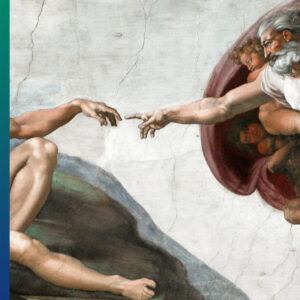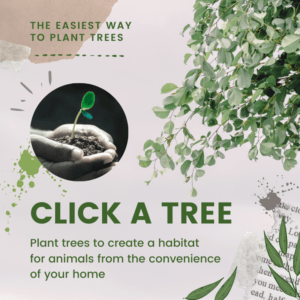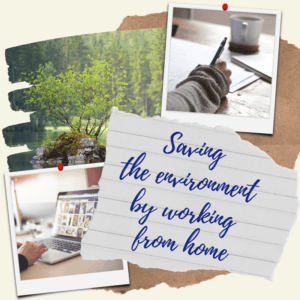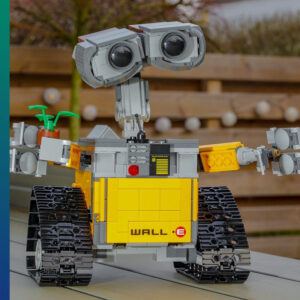
Why go for a green lifestyle and invest in future generations? Perhaps the more important question is, how to go for a green lifestyle. And why for future generations?
The answer to this second question is fairly simple. When we want to go for a green lifestyle, this can only be achieved with major disruptions to our personal lives. This is why we have to start to dream about our green future, and with this dream in mind make small steps to get there. But where do our dreams start?
On a boarded-up building in Santa Monica in California (USA), is written: “After The Plague Came The Renaissance”. The slogan is illustrated with the two hands of “The Creation of Adam”. These hands are part of a painting Michelangelo made between 1508 and 1512 on the ceiling of the Sistine Chapel in Rome.
This is a quote full of hope. The message is clearly meant to lift our spirits. Although the current pandemic is hardly comparable with the plague that during at least 5 centuries in wave after wave killed millions of people.
Table of contents
What will our Renaissance be?

Is there a Renaissance in store for us? If so, what would our Renaissance look like? The core idea which emerged during the Renaissance was that ‘man is the measure of all things’. This idea, no doubt, founded the individualism that still dominates our present way of living.
What idea or ideas will dominate the ages to come? The maxim we hear frequently is: “After the virus, we go back to the old normal.” Does this really inspire us? Are we really that much easier to satisfy than the Europeans of the post-plague era?
Most of us are already happy to celebrate the holidays with the family members on Zoom. So I am inclined to say yes, we are much easier to satisfy, compared to our ancestors. But is this the best way to invest in powerful future generations?
The Second Renaissance
In retrospect, it wasn’t difficult to explain the rise of the Renaissance. Although it’s a widely debated concept. At present, now we’re still in the middle of the pandemic, it’s truly different.
Predicting our future has always been a challenge. Under the current conditions, it’s even more so. To wrap up our current life with a future poignant characteristic is an interesting challenge though. The question is of course: Will our future be as uplifting as the Renaissance?

What will be our measure of all things? Assuming that ‘back to the old normal’ is not what we aspire. However, what do we aspire to achieve? What do we crave for? Will our efforts, and inspiration be able to launch The Second Renaissance?
The Era of Dyson
In the #13 issue of The New York Review of Books of 2009, Freeman Dyson (1923-2020) reviewed Richard Holmes’s The Age of Wonder: How the Romantic Generation Discovered the Beauty and Terror of Science. Freeman Dyson was a theoretical and mathematical physicist, mathematician, and statistician. (Richard Holmes’s book is a ‘must read’ by the way.)
Dyson is known for his wide area of interests and his creative and precise ideas. At the end of his review, he predicts a new and future age of wonder. An age in which artists create “genomes as fluently as Blake and Byron wrote verses”. These genomes would produce “an abundance of new flowers and fruits and trees and birds to enrich the ecology of our planet.”
Wealthy entrepreneurs, academic professionals, and “a worldwide community of gardeners and farmers and breeders”, are supposed to make the planet beautiful, fertile and hospitable “to hummingbirds as well as to humans”. Let’s call this the first type of The Second Renaissance: The Era of Freeman.
The Era of Esther

Discrimination against women started with the first stories told in the Old Testament. Adam was the first human being. Eva was made from one of his ribs. We now know fairly well that this must have been the other way around. Adam was born from the womb of Eva. Although this offers a bunch of new dilemmas, it sounds more logical.
At present, it becomes more and more clear that women perform better than men on all accounts. They’re better politicians, better pilots, better doctors, etc. The countries led by female leaders did better during the pandemic.
Even one of the most influential persons in the computer world is a woman: Esther Dyson (yes, the daughter of Freeman Dyson).
Apparently we, more specifically women, already with some success shook up the gender bias (a euphemism for the discrimination of women). Of course, the measure of all things must be women as well as men.
However, for the time being, it does no harm to call the second type of The Second Renaissance: The Era of Eva. Or The Era of Esther, when you want to keep it in the family.
The Era of Color
Let us try to be a bit more creative, and expand our ideas. The ambition is that every human being is the measure of all things! No matter whether they are black, blue, brown, green, red, yellow, or white. As you can see, the Black Lives Matter movement justifiably put some priorities in the order of color.

When I was young I had many friends whose parents originated from Sri Lanka, Sumatra, Java, The Moluccas, or Surinam. Back then, I never made the link between my friends and Dutch colonial history. Only later, with a growing political and historical awareness, I realized something was definitely wrong.
Not that they lived in The Netherlands, because I always appreciated their friendship, their different culture, and the delightful food they made. What was and still is wrong, is that at school they taught us how good and beautiful the Dutch colonial history was.
Perhaps this has changed, but I don’t trust the Dutch educational system enough given the tremendous amount of discrimination against people with different cultural backgrounds. For now, it is enough to emphasize that in retrospect our Second Renaissance will perhaps be called: The Era of Color. That would warm my heart.
The Era of EVE
Together with my two grandsons, I’ve seen the PIXAR animation movie WALL•E twice. WALL•E means “Waste Allocation Load Lifter Earth-Class”. It’s the last robot left on earth. On earth, there are no humans anymore.

The robot is programmed to clean up the planet, “one trash cube at a time.” After 700 years, WALL•E developed one little technical anomaly: a nosy personality. He is also lonely. Then he meets EVE. EVE is also a robot. She is however very different from WALL•E.
EVE is on a search mission. The goal of this mission is to find out whether planet earth is inhabitable. EVE discovers that WALL•E found the solution. Although he is not aware of this. EVE immediately returns to her home base in space to tell the good news. WALL•E follows her.
On EVE’s home base, a space station, live the last humans. These humans are young children. Together, EVE and WALL•E go through many adventures on EVE’s home base fighting the space station’s central computer. Finally, they are able to control the space station and return to earth, with the intention to colonize it again. End of story.
At present, most billionaires are interested in artificial intelligence and space travel. This makes the story of a space station, as the last refuge of humankind, rather credible. Will our Second Renaissance enact in space?
In prospect, if this space-age ever materializes let’s call this The Era of EVE. What more could we wish for than that our Second Renaissance is named after a female robot who offered a second chance to humans on the planet earth?
The Era of Gaia
The phenomenal Foundation sequence of the science-fiction writer Asimov is part of the vast and ageless fictional literature featuring a quest. From Arthur’s knights searching for The Holy Grail to On The Road of Jack Kerouac, this search will probably never end.
When it comes to the quest for our future, which is the era we want to establish? How much room will we offer future generations to search for their own holy grail? From the present outlook, this future looks rather bleak, and what we have to offer our grandchildren and their children can hardly be called a present.
Go for a green lifestyle
This is why we must fight now for the Era of Gaia:
- We have to shake off the idea that humans are “the measure of all things”;
- At the same time, we are personally responsible;
- Restoration and conservation of biodiversity must be our main goal;
- Food production must completely be tuned to this goal;
- We all must start living green;
- Sustainability must be at the center of our green lives;
- We must convince each other about the truth of our green agenda.
How can we together contribute to each other’s green lifestyle? Please write your suggestions in the comment box.
Some of the links are affiliate links. As an affiliate associate, we earn a commission when you purchase any of the products offered through the shared links at no extra cost for you. This helps us maintain this website.

Hey Hannie,
That’s a very powerful and thoughtful piece that you came up with. I absolutely agree with you that a greener future is the only way we can support our generation and many more generations to come. We certainly don’t have to realize the EVE renaissance, but what can we do? A.I. has his head and trunk already in the room?
Hi Sergej,
Thank you for your comment and compliments.
A.I. is manmade and as all manmade objects, it has many flaws. One of the biggest flaws of A.I. is that people think it will solve all the worlds’ problems. This indicates that people know nothing of the technology they develop.
One thing is certain, technology is not going to guarantee a green lifestyle, nor is it an investment in powerful future generations. For this, we, and the future generations, will have to make our and their own green choices.
If possible together, if not we’re left on our own and have to arrange our green lives ourselves. Meaning that no matter what, we have to invest primarily in ourselves.
For now, stay safe, stay healthy.
Regards,
Tom
What a good reflection! Undoubtedly, the pandemic situation we are living with all the consequences it has brought and what it will bring both socially, health and economically is a turning point to question the way we are living. I am also committed to a green lifestyle. I think we are heading in the right direction but there is still a long way to go. Hopefully we will be able to take what we have learned from this crisis situation to improve and design a more sustainable and healthier future for both ourselves and the planet.
Personally, one of the things that worries me most at present is the large amount of waste that we generate and that ends up in the sea or in other parts of the planet, seriously damaging the ecosystem. The dangerous thing is that we live without being aware of the impact that our way of living generates on the planet and this leads us to keep doing the same thing over and over again without thinking much more about it.
Thank you very much for this!
Hi Marta,
The question is of course: Who are the ‘we’ you introduce? When you refer to everybody on the planet, that is a very huge amount of people. To change all these people is an enormous challenge.
Moreover, what is the right direction? And do we have to wait until we all agree on that direction? The current pandemic shows that almost nobody understands what is happening, let alone that they are able and prepared to learn something from what is happening. Almost everybody thinks that a vaccine will end the pandemic and everything will be ‘back to normal’.
Nevertheless, a better world starts with ourselves. It’s a cliche, I know, yet it appeals to you, you already live a green lifestyle, and it appeals to us. Moreover, you and we are also committed to publishing our green lifestyle ideas. Let’s keep up this good work.
Thank you very much for your comment and compliments.
For now, stay safe, stay healthy.
Regards,
Tom
Unfortunately, I think that until something hits us hard, we will barely change. It’s hard to change the whole world, but I hope that will happen soon. Too many things are wrong on this planet.
I think that there’s only one way for a complete change – the governments. When they start to agree with green solutions and everything completely, people will change too.
Besides that, everyone should change themselves as much as possible. I see too much trash around the road, which is not the government’s problem – it’s a problem of every individual.
Hi Petar,
Are you sure it’s hard to change the whole world? As far as I understand, we humans changed already quite a lot, and are still changing a lot.
We changed the climate, destroyed many ecosystems and much of biodiversity, poisoned the air and the water we depend upon … That’s enough change to last a lifetime.
However, what you probably mean is that it takes some effort to change humans in such a way that the damage will be reversed. As a matter of fact, most of my life I’ve been preoccupied with questions concerning the science of human change. You better not dig too deep into this science because you will easily lose all faith in humanity.
I agree that governments have to take the lead and that we also should do a lot ourselves, for instance by giving a good example. However, when it comes to green solutions, there is a catch. When we don’t prioritize poverty in the world, no green solutions will ever succeed. I will explain this in an upcoming article.
Thank you for your comment. For now, stay safe, and stay healthy.
Regards,
Tom
Hi Tom, Thank you for the great detailed and engaging description of the eras. I don’t watch science fiction movies but will undoubtedly buy Richard Holmes’ book, which sounds interesting.
I hate every discrimination, and I believe that the Netherlands still have their pride in the colonial era, whereby they have mistreated the slaves.
Once in New Zealand, when we stayed with a New Zealand older couple, I ask the man about the history and the real people of New Zealand, and he said, history started 200 years ago with the first settlers coming to New Zealand, that they are the first inhabitants of this country. He didn’t mention the Maoris and didn’t want to listen to me correcting him. I was astonished by this arrogant behavior. Wow, there are people on this planet who surprise you with their arrogance.
Saving and recovering the health of our planet is only possible if we all start to live sustainably and go completely green. There is no other option than boycotting exploiting industry, forcing them to produce sustainable products and stop using pesticides and herbicides. Even I have a garden for insects and birds, and small mammals; I see fewer bees in my garden, especially bumblebees and butterflies.
Governments need to stop giving subsidies to industries that damage and pollute the environment. But there is no interest or only a bit.
Anyway, I am so pleased about people coming together, fighting for our Mother Earth. This is so positive and hopefully our future world system.:)
Hi Sylvia,
Thank you for your comment and your encouraging compliments.
Your example of the man in New Zealand doesn’t surprise me. Spain denies, until this very day, they exterminated almost all of the native inhabitants of South America. In the 16th century, the Spanish friar Bartolomé de las Casas tried to halt the brutal killings, but in vain.
Today I read on German and US newspaper websites that Germany finally admitted to having committed horrendous atrocities, during the short period they occupied Nambia at the beginning of the 20th century. Slowly, but very slowly, we start to face the not-so-very-pleasant behaviors of our ancestors.
By the way, the Brexit was largely driven by the sentiments the New Zealander so arrogantly shared with you. He is certainly not alone. Together they still can produce enough power to take a wrong turn in history.
This means, of course, we can only change something on this planet when we together mobilize the same powers, as you explain.
For now, stay safe, stay healthy.
Regards,
Tom